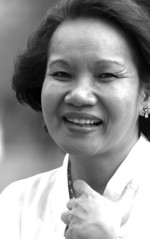
LOGARTA
Reading Resil Mojares has always been a very stimulating experience. Upon learning that he had been proclaimed National Artist I was overjoyed for many reasons. First of all, local history is very important for young Cebuanos, especially in this age of globalization and the danger of homogenization.
Mojares’ research and books provide us with a great deal of material to learn about our past, our culture, the kind of people we are. For this reason, the collection of selections for teaching Philippine History including local history is full of material of Resil Mojares.
Because I wanted to include women, I was glad to read the following from his book on Casa Gorordo: “Traditionally, however, the women were often active participants in the family business — as witness the careers of such late nineteenth-century ladies as Doña Fausta Regis, Doña Damiana Veloso, and Doña Benigna Cui doing inventories of harvests, dealing with tenants and managing household finances. They sponsored plays and entertainment, ran their own business (like Doña Petra Veloso who operated a funeral parlor in Tinago or Doña Gabriela Vasquez de Bondoc who had a fabrica de ojaldres on Calle Pizarro, (now Zulueta) or gave lessons in music (as did Felicidad Climaco at her house on Alfonso XIII) or languages (as did Josephine Bracken, Rizal’s widow who had married Miguel Abad, a Cebuano, at her home on Magallanes near Plaza Rizal).”
“The Gorordo women discharged these functions. Doña Telesfora Garces, the Bishop’s mother actively engaged in agriculture and trade and managed the household as her husband died when their children were still quite young. The younger generation of Gorordo women also kept busy by running a home-based business of filling orders for cakes and desserts. They were good pastry cooks and supervised the household help in turning out tortas, ensaimada, polvoron, and other kinds of cakes and sweets. They managed the household: kept family accounts, superintended the work in the kitchen, had the servants about such tasks as dusting the furniture with a plumero (chicken feathers tied to a stick), and keeping the mahogany floors buffed with coconut husk and home-made wax made out of melted candles, kerosene, and annatto seeds (achuete). They were hostesses to the bishop’s guests. Family visitors included Don Sergio Osmeña — ‘who was like a brother to the Bishop’ — and such other prominent residents of the city as Juan and Arsenio Climaco. Don Pedro Cui, Dionisio Jakosalem, and the family physician, Dr. Max Borromeo.”
In including a section of The War Against the Americans: Resistance and Collaboration in Cebu 1899 -1905, it is pointed out that: “Mojares’ narration avoids the bipolar categorization of Filipino and American, or elite and lower class. Instead, he demonstrates the presence of various sectors within the elite. Neither does he categorize the Americans in sweep — he carefully presents the individuals.”
“The motivations and backgrounds, even of specific Cebuanos, are thoroughly described together with their standpoints. Adhering to journalistic principles of fairness and balance. Mojares explains the conservative position of Bishop Martin Garcia Alcocer and native Fr. Pablo Singson, side-by-side the support of Fr. Francisco Blanco and Fr. Francisco Latorre for the Anti American forces.”
“Mojares discusses collaboration in its complexity, never simplistically and does the same for the resistance. He vividly portrays how a determined but resource-limited group could have a wide range of ways of resisting: ‘flight, silence, subterfuge, and other varieties of sabotage and non-cooperation.’”
Like Madz de la Cerna the works of Resil Mojares became part of my resources in my graduate studies. His “The Man Who would Be President, Serging Osmeña and Philippine Politics” was a reference for the class with “Randy David on Society and Economy.” His “Theatre in Society, Society in Theatre was one of the readings for my comprehensive examination.”
During the launching of Resil Mojares’ books, I try to buy more than one copy because I have found them so very beautifully written and full of enlightening information that I have gifted many dear ones with Mojares-authored books, always full of wisdom and warmth. Recently, I gave Redemptorist friends a copy of the book on the Sto. Niño and the Mojares Reader to my high school English teacher, Dr. Esperanza Abrajano. And one can go on and on about his various works.
Dr. Resil Mojares, we cannot thank you enough for how much you have enriched our Cebuano consciousness!
Disclaimer: The comments uploaded on this site do not necessarily represent or reflect the views of management and owner of Cebudailynews. We reserve the right to exclude comments that we deem to be inconsistent with our editorial standards.
